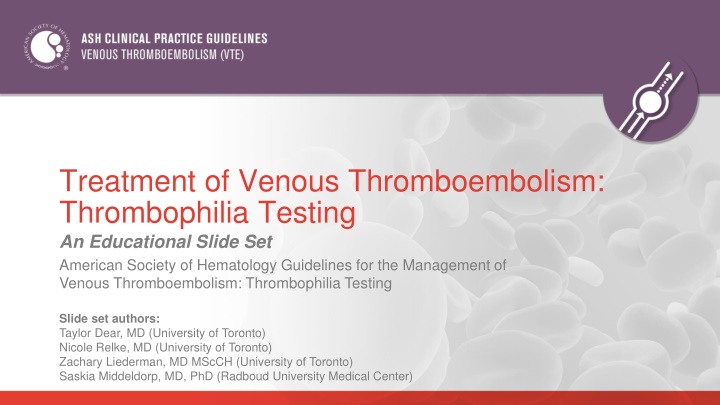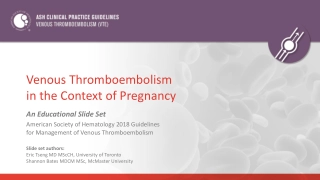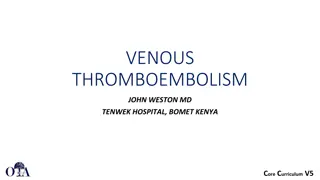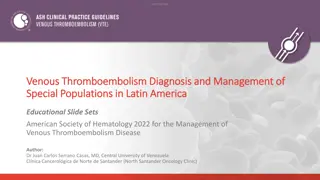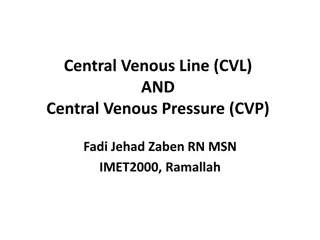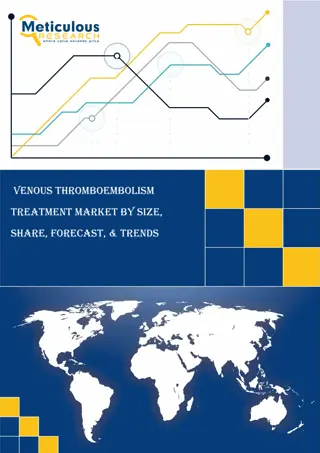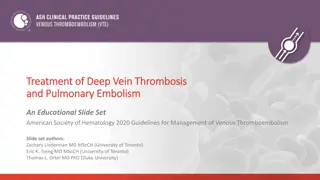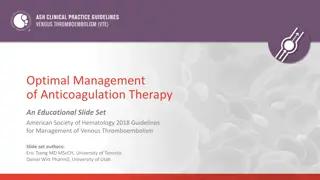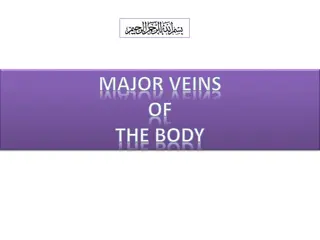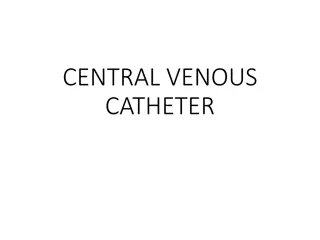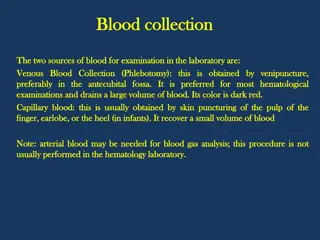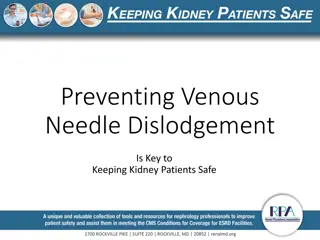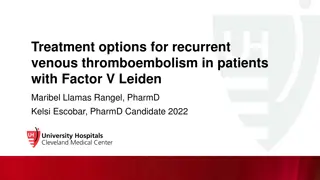Guidelines for Thrombophilia Testing in Venous Thromboembolism Management
The American Society of Hematology (ASH) provides comprehensive guidelines for the management of venous thromboembolism (VTE) with a focus on thrombophilia testing. Expert panels develop recommendations based on clinical questions, evidence synthesis, and resource use. These guidelines cover various aspects of VTE, including prevention in cancer patients, anticoagulation in COVID-19, and treatment strategies. Recommendations are regularly reviewed and updated to ensure evidence-based practice in VTE management.
Download Presentation

Please find below an Image/Link to download the presentation.
The content on the website is provided AS IS for your information and personal use only. It may not be sold, licensed, or shared on other websites without obtaining consent from the author.If you encounter any issues during the download, it is possible that the publisher has removed the file from their server.
You are allowed to download the files provided on this website for personal or commercial use, subject to the condition that they are used lawfully. All files are the property of their respective owners.
The content on the website is provided AS IS for your information and personal use only. It may not be sold, licensed, or shared on other websites without obtaining consent from the author.
E N D
Presentation Transcript
Treatment of Venous Thromboembolism: Thrombophilia Testing An Educational Slide Set American Society of Hematology Guidelines for the Management of Venous Thromboembolism: Thrombophilia Testing Slide set authors: Taylor Dear, MD (University of Toronto) Nicole Relke, MD (University of Toronto) Zachary Liederman, MD MScCH (University of Toronto) Saskia Middeldorp, MD, PhD (Radboud University Medical Center)
Clinical Guidelines American Society of Hematology 2023 Guidelines for Management of Venous Thromboembolism: Thrombophilia Testing Middeldorp S, Nieuwlaat R, Baumann Kreuziger L, Coppens M, Houghton D, James A, Lang E, Moll S, Myers T, Bhatt M, Chai Adisaksopha C, Colunga Lozano LE, Karam SG, Zhang Y, Wiercioch W, Schu nemann HJ, Iorio A
ASH Clinical Practice Guidelines on VTE 1. 2. 3. 4. 5. 6. 7. 8. 9. 10. Prevention and Treatment of VTE in Patients with Cancer 11. Anticoagulation in Patients with COVID-19 12. Adaptation of ASH Management of VTE Guidelines for Latin America Prevention of VTE in Surgical Hospitalized Patients Prevention of VTE in Medical Hospitalized Patients Diagnosis of VTE Optimal Management of Anticoagulant Therapy Heparin-Induced Thrombocytopenia (HIT) VTE in the Context of Pregnancy Thrombophilia Testing Treatment of Pediatric VTE Treatment of Acute VTE (DVT and PE)
How were these ASH guidelines developed? PANEL FORMATION Each guideline panel was formed following these key criteria: Balance of expertise (including disciplines beyond hematology, and patients) Close attention to minimization and management of COI CLINICAL QUESTIONS 20-30 clinically-relevant questions generated in PICO format (population, intervention, comparison, outcome) EVIDENCE SYNTHESIS Evidence summary generated for each PICO question via systematic review of health effects plus: Resource use Feasibility Acceptability Equity Patient values and preferences MAKING RECOMMENDATIONS Recommendations made by guideline panel members based on evidence for all factors. Example: PICO question Should thrombolytic therapy in addition to anticoagulation vs. anticoagulation alone be used for patients with extensive proximal DVT?? ASH guidelines are reviewed annually by expert work groups convened by ASH. Resources, such as this slide set, derived from guidelines that require updating are removed from the ASH website.
How patients and clinicians should use these recommendations STRONG Recommendation ( The panel recommends ) CONDITIONAL Recommendation ( The panel suggests ) Most individuals would want the intervention. A majority would want the intervention, but many would not. For patients Different choices will be appropriate for different patients, depending on their values and preferences. Use shared decision making. Most individuals should receive the intervention. For clinicians
Introduction Thrombophilia: acquired or hereditary conditions with higher-than-normal risk of VTE Thrombophilia testing has several potential advantages and disadvantages: Advantages Disadvantages Improved risk stratification of VTE Risk of false negatives (missed diagnosis) and false positives (overdiagnosis) Guides treatment and prevention of VTE Potential for physical, psychological, or financial harm to patients Guideline purpose: Provide evidence-based recommendations about whether thrombophilia testing and tailoring management based on results, improves patient-important outcomes.
Objectives By the end of the session, you should be able to: 1. Review the prevalence and risks associated with hereditary thrombophilia 2. Describe when thrombophilia testing may be indicated in patients with symptomatic VTE 3. Describe recommendations for thrombophilia testing in asymptomatic patients with a family history of VTE/thrombophilia
For each clinical question, the panel compared two scenarios: Thrombophilia Testing Intervention in only the individuals found to have the thrombophilia No thrombophilia Testing Usual care in all individuals Depending on the specific question, for patients positive for thrombophilia, interventions include: Indefinite Anticoagulation Thromboprophylaxis Avoidance of Thrombotic Risk Factor
Treatment (anticoagulation) effect For example, in a patient with a history of a provoked VTE, where stopping anticoagulation is usual care: Bleeding Thrombosis Indefinite Anticoagulation Thrombophilia Thrombophilia Testing No Thrombophilia Stop Anticoagulation No Thrombophilia Testing Stop Anticoagulation in All Status Unknown In providing a recommendation, the panel considered: Risk of bleeding vs. recurrent thrombosis Cost & burden of thrombophilia testing/anticoagulant treatment Patient preferences
Thrombophilia testing in patients with VTE Prevalence, Median % (Min-Max) RR for VTE Recurrence - Positive vs Negative (95% CI) Treatment effect for VTE recurrence, RR (95% CI) Treatment effect for major bleeding, RR (95% CI) Any Thrombophilia 38.0 (21.6-59.5) Low Risk 17.5 (4.1-34.8) 1.65 (1.28-2.47) FVL Heterozygous 1.36 (1.19-1.57) Prothrombin gene mutation 6.1 (1.4-16.3) High Risk 1.5 (0.3-3.1) 1.34 (1.05-1.71) 0.15 2.17 (0.10-0.23) (1.40-3.35) FVL Homozygous 2.10 (1.09-4.06) Antithrombin (AT) Deficiency* 2.2 (0.2-8.7) 2.07 (1.50-2.87) Protein C (PC) Deficiency* 2.5 (0.7-8.6) 2.13 (1.26-3.59) Protein S (PS) Deficiency * 2.3 (0.7-7.3) 1.30 (0.87-1.94) *Results influenced by hormone use, timing of testing and anticoagulation
Case 1: Unprovoked VTE 52 year old male Past Medical History: None Diagnosis: Unprovoked symptomatic right leg DVT Treatment: He has been treated with anticoagulation for 3 months without any bleeding concerns
Usual Care Indefinite antithrombotic therapy is suggested in most individuals with unprovoked VTE (Treatment of VTE ASH guideline) Thrombophilia testing strategy would mean that patients without thrombophilia would stop anticoagulant therapy (potential for more thrombosis and less bleeding) What management strategy do you suggest? a. b. No thrombophilia testing and indefinite anticoagulation Thrombophilia testing and stop anticoagulation in patients without thrombophilia
Recommendation 1 In patients with unprovoked VTE who have completed primary short term treatment, the ASH guideline panel suggests not to perform thrombophilia testing to guide the duration of anticoagulant treatment (conditional recommendation, low certainty) Impact of thrombophilia testing strategy per 1000 patients (620 fewer patients treated with indefinite anticoagulation) Outcomes Recurrent VTE 42 more VTE recurrences (ranging from 17 to 67) Major Bleeding - Low Risk (0.5% per year) 4 fewer major bleeds (ranging from 1 to 9) Major Bleeding High Risk (1.5% per year) 11 fewer major bleeds (ranging from 2 to 28) Quality of Evidence (GRADE): Low or Very Low Moderate High
Case 2: Provoked VTE 35-year-old female Past Medical History: Hypertension Past Surgical History: Appendectomy Diagnosis: Pulmonary embolism on post-operative day 21 following appendectomy Treatment: She is started on anticoagulation and referred for outpatient assessment
Usual Care Individuals with VTE provoked by surgery discontinue anticoagulant therapy after primary treatment (Treatment of VTE ASH guideline) Thrombophilia testing strategy would mean that patients with thrombophilia would receive indefinite anticoagulant therapy (potential for less thrombosis and more bleeding) What management strategy do you suggest? a. No thrombophilia testing, treat for 3 months and stop anticoagulation b. Thrombophilia testing and indefinite anticoagulation only in patients with thrombophilia
Recommendation 2 In patients with VTE provoked by surgery who have completed primary short-term treatment, the ASH guideline panel suggests not to perform thrombophilia testing to determine the duration of anticoagulation treatment (conditional recommendation, very low certainty of evidence) Impact of thrombophilia testing strategy per 1000 patients (380 more patients treated with indefinite anticoagulation) Outcomes Recurrent VTE 4 fewer VTE recurrences (ranging from 2 to 7) Major Bleeding - Low Risk (0.5% per year) 2 more major bleeds (ranging from 0 to 7) Major Bleeding - High Risk (1.5% per year) 7 more major bleeds (ranging from 1 to 21) Quality of Evidence (GRADE): Low or Very Low Moderate High
Case 3: Pregnancy 24-year-old female, G1P0, 35+3 weeks gestation Past Medical History: None Diagnosis: Left leg DVT after presenting with a 2-day history of increasing left leg swelling and pain Treatment: She is started on anticoagulation and referred for outpatient assessment
Usual Care Individuals with VTE provoked by pregnancy will discontinue anticoagulant therapy after primary treatment (Treatment of VTE ASH guideline) Thrombophilia testing strategy would mean that patients with thrombophilia would receive indefinite anticoagulant therapy (potential for less thrombosis and more bleeding) What management plan do you suggest? a. No thrombophilia testing, treat for 3 months and stop anticoagulation b. Thrombophilia testing and indefinite anticoagulation only in patients with thrombophilia
Case 4: Non-Surgical Major Transient Risk Factor 64-year-old male Past Medical History: None Medications: Naproxen PRN Diagnosis: Left leg DVT diagnosed on day 3 of admission for pneumonia. While in hospital he is relatively immobile, only getting up to use the washroom Treatment: He is started on anticoagulation and referred for outpatient assessment
Usual Care Individuals with VTE provoked by non-surgical major transient risk factors will discontinue anticoagulant therapy after primary treatment (Treatment of VTE ASH guideline) Thrombophilia testing strategy would mean that patients with thrombophilia would receive indefinite anticoagulant treatment (potential for less thrombosis and more bleeding) What management plan do you suggest? a. No thrombophilia testing, treat for 3 months and stop anticoagulation b. Thrombophilia testing and indefinite anticoagulation only in patients with thrombophilia
Recommendations 3-5 In patients with VTE provoked by a non-surgical major transient risk factor, combined oral contraceptives, pregnancy or postpartum who have completed primary short-term treatment, the panel suggests testing for thrombophilia to guide anticoagulant treatment duration (conditional recommendation, very low certainty) Impact of thrombophilia testing strategy per 1000 patients (380 more patients treated with indefinite anticoagulation) Outcomes Recurrent VTE 21 fewer VTE recurrences (ranging from 10 to 35) Major Bleeding - Low Risk (0.5% per year) 2 more major bleeds (ranging from 0 to 7) Major Bleeding - High Risk (1.5% per year) 7 more major bleeds (ranging from 1 to 21) Quality of Evidence (GRADE): Low or Very Low Moderate High
American Society of Hematology 2020 Guidelines (Treatment of VTE) Transient Risk Factors (resolve after provoked VTE) Chronic (Persistent) Risk Factors (persistent after VTE occurs) Active cancer (ongoing chemo; recurrent or progressive disease) Inflammatory bowel disease Autoimmune disorder (e.g., antiphospholipid syndrome, rheumatoid arthritis) Chronic infection Chronic immobility (e.g., spinal cord injury) Major Risk Factor Surgery, gen anesthesia > 30 min Confined to hospital bed 3 days with acute illness Cesarean section Minor Risk Factor Estrogen therapy (OCP, HRT) Pregnancy, puerperium Confined to bed out of hospital 3 days with acute illness Leg injury, reduced mobility 3 days Ortel Blood Adv 2020
Case 5: Unusual site thrombosis 44-year-old male assessed in follow up Past Medical History: Hypertension Diagnosis: Unprovoked cerebral venous thrombosis diagnosed 2 years earlier Treatment: In discussion with the patient, you have decided to continue with indefinite anticoagulation
Guidelines are indecisive on duration of anticoagulation for unusual site VTE Thrombophilia testing strategy impact is dependent on clinicians' usual care. Primary short term treatment only planned patients with thrombophilia would receive indefinite anticoagulant treatment (potential for less thrombosis and more bleeding) Indefinite anticoagulation planned patients without thrombophilia would stop anticoagulant therapy (potential for more thrombosis and less bleeding) The patient is interested in thrombophilia testing. What management plan do you suggest? a. No thrombophilia testing and indefinite anticoagulation b. Thrombophilia testing and stop anticoagulation if negative
Recommendations 7-8 In patients with Cerebral Venous Thrombosis who have completed primary short-term treatment, the panel suggests testing for thrombophilia to guide anticoagulant treatment duration only if anticoagulation would be discontinued otherwise (conditional recommendation, very low certainty) Impact of thrombophilia testing strategy per 1000 patients Additional factors may influence thrombophilia testing/ treatment and were not included in analysis Indefinite anticoagulant therapy planned (564 fewer patients treated with indefinite anticoagulation) Primary treatment only planned (436 more patients treated with indefinite anticoagulation) Outcomes Provoked vs. unprovoked Additional thrombophilia (e.g. JAK 2 mutation) Recurrent VTE 18 fewer VTE recurrences (14 to 23) 14 more VTE recurrences (10 to 18) Major Bleeding - Low Risk 3 more major bleeds (1 to 5) 3 fewer major bleeds (1 to 7) Major Bleeding - High Risk 8 more major bleeds (3 to 16) 10 fewer major bleeds (3 to 20) Quality of Evidence (GRADE): Low or Very Low Moderate High
Summary of Thrombophilia Testing Strategy for Patients with VTE Treatment Risk for Major Bleeding Intermediate Risk of recurrent thrombosis: Testing can tip the balance towards indefinite anticoagulation (thrombophilia positive recurrent VTE risk > bleeding risk) Base Risk of VTE Recurrence (1styear) Recommended Strategy for Thrombophilia Testing Unprovoked High (10%) Do Not Test (indefinite anticoagulation in all) Do Not Test (indefinite anticoagulation in all) OR Test (indefinite anticoagulant therapy in patients with thrombophilia) Intermediate (2.7%-3.8%) Unusual Site High or Low Risk of recurrent thrombosis: Testing does not cross treatment thresholds (i.e. for unprovoked VTE, recurrent VTE risk > bleeding risk regardless of thrombophilia test results) 0.5-1.5% Provoked (non-surgical) Test (indefinite anticoagulant therapy in patients with thrombophilia) Intermediate (5%) Provoked (surgical) Do Not Test (primary short-term anticoagulation in all) Low (1%)
Introduction to thrombophilia testing in individuals with a family history of VTE and/or thrombophilia In families with VTE, the panel examined patient outcomes from testing asymptomatic individuals (relatives) for thrombophilia The panel considered two scenarios: 1. Known specific thrombophilia in affected family member (proband) Selective thrombophilia testing 2. Unknown thrombophilia status Panel thrombophilia testing When outcomes were similar, the panel favored selective over panel testing
Thrombophilia testing in individuals with family history of VTE Treatment effect for VTE occurrence, RR (95% CI) Treatment effect for major bleeding, RR (95% CI) Panel Testing: testing for APLA and all hereditary thrombophilia types RR for 1stVTE - Positive vs Negative (95% CI) Low Risk Selective Thrombophilia Testing: testing for a specific thrombophilia type (i.e. family testing) FVL Heterozygous 2.71 (2.06-3.56) Prothrombin (PT) Mutation 2.35 (1.46-3.78) 0.54 2.09 High Risk (0.32-0.91) (1.33-3.27) Antithrombin (AT) Deficiency 12.17 (5.45-27.17) Protein C (PC) Deficiency 7.47 (2.81-19.81) Protein S (PS) Deficiency 5.98 (2.45-14.57)
Case 6: Family history of VTE and minor provoking risk factor 22-year-old female is assessed as an outpatient following a severe high grade ankle sprain being managed non-operatively. Non-weightbearing and immobilization are recommended for the next 10 days Past Medical History: None Medications: None Family History: Mother has a history of DVT. To her knowledge, her mother has not been tested for thrombophilia
Usual Care No thromboprophylaxis for medical outpatients with minor provoking risk factors for VTE (Prophylaxis for Medical Patients ASH guideline) Thrombophilia testing strategy would mean that individuals with thrombophilia would receive thromboprophylaxis for a minor provoking factor (potential for less thrombosis and more bleeding) What management plan do you suggest? a. b. No thrombophilia testing and no thromboprophylaxis Thrombophilia testing and start anticoagulant thromboprophylaxis if positive
Recommendation 13 In individuals with a minor risk factor who have a family history of VTE and unknown thrombophilia status, suggest not to perform thrombophilia testing to guide thromboprophylaxis (conditional recommendation, very low certainty) Impact of thrombophilia testing strategy in first degree relatives of patients with VTE per 1000 episodes (142 more patients receive thromboprophylaxis) Recommendations assume no time delay for testing Outcomes Recurrent VTE 2.16 fewer VTE (0.02 to 5.66) Major Bleeding 0.62 more major bleeds (0.13 to 1.82) Quality of Evidence (GRADE): Low or Very Low Moderate High
Recommendations 11-12 In individuals with a minor provoking risk factor who have a family history of VTE and known thrombophilia, suggest thrombophilia testing to guide thromboprophylaxis for high risk thrombophilia but not low risk thrombophilia (conditional recommendation, very low certainty) Impact of selective thrombophilia strategy in first degree relatives of patients with VTE per 1000 episodes (500 more patients treated with thromboprophylaxis) Family History Major Bleeding VTE Low Risk FVL Heterozygous 5.04 fewer VTE (0.91 to 7.96) Prothrombin mutation 4.84 fewer VTE (0.80 to 8.07) 2.18 more bleeds (0.66 to 4.54) High Risk Antithrombin Deficiency 21.25 fewer VTE (3.80 to 32.79) Protein C Deficiency 20.28 fewer VTE (3.32 to 32.37) Protein S Deficiency 19.79 fewer VTE (3.20 to 31.82) Quality of Evidence (GRADE): Low or Very Low Moderate High
Case 7: Combined Oral Contraceptive (COC) pill or Hormone Replacement Therapy (HRT) use The same patient is re-referred 2 years later. She would like to start the combined oral contraceptive pill for pregnancy prevention Her past medical history is unchanged and she is not on any regular medications Since the initial visit, her sister developed an unprovoked PE and was found to have Protein C Deficiency
Thrombophilia testing strategy would mean that individuals with thrombophilia would avoid COC and HRT (potential for less thrombosis) She is looking to start combined oral contraceptive pill for prevention of pregnancy. What management plan do you suggest? a. b. No thrombophilia testing and start COC Thrombophilia testing and suggest against COC if positive
Recommendations 19-20 In individuals with a family history of VTE and known thrombophilia, suggest selective thrombophilia testing to guide COC or HRT for high risk thrombophilia only (conditional recommendation, very low certainty) Impact of selective thrombophilia testing strategy on VTE episodes per 1000 women who are first degree relatives of patients with VTE / year (500 fewer using COC or HRT)* Family History HRT COC Low Risk FVL Heterozygous 4.57 fewer VTE (3.75 to 5.55) 1.36 fewer VTE (0.21 to 1.96) Prothrombin mutation 4.38 fewer VTE (3.76 to 4.90) 2.20 fewer VTE (0.25 to 4.79) High Risk Antithrombin Deficiency 19.39 fewer VTE (15.30 to 23.90) 6.45 fewer VTE (0.77 to 13.49) Protein C Deficiency 13.84 fewer VTE (11.34 to 15.45) 4.94 fewer VTE (0.60 to 10.12) Protein S Deficiency 10.49 fewer (8.71 to 11.48) 3.92 fewer VTE (0.47 to 7.87) Quality of Evidence (GRADE): Low or Very Low Moderate High
Recommendations 15-18 In individuals from the general population suggest not to perform thrombophilia testing to guide the use of COC (strong recommendation, low certainty) or HRT (conditional recommendation, low certainty) In individuals with a family history of VTE and unknown thrombophilia, suggest not to perform thrombophilia testing to guide the use of COC or HRT (conditional recommendation, very low certainty) Impact of thrombophilia testing strategy on VTE per 1000 women / year (69-142 fewer using COC or HRT)* The potential harms of hormone avoidance fall outside the guidelines scope but may include unwanted pregnancies and postmenopausal symptoms. HRT COC 0.26 fewer VTE (0.09 to 0.65) 0.29 fewer VTE (0.01 to 1.98) General Population Family History of VTE (1st degree) and Unknown Thrombophilia 1.17 fewer VTE (0.06 to 1.55) 0.94 fewer VTE (0.01 to 5.16) Quality of Evidence (GRADE): Low or Very Low Moderate High
Case 8: Women who are planning pregnancy 26 year old female is planning to become pregnant, and was referred for a family history of VTE and FVL. The patient has not undergone testing for thrombophilia, and she has no history of VTE Past Medical History: None Medications: None Family History: Sister has a history of DVT and is homozygous for FVL
Usual Care No antepartum or postpartum thromboprophylaxis for women with no or 1 clinical risk factor (Pregnancy ASH guideline) Thrombophilia testing strategy would mean that patients with thrombophilia would receive antepartum and/or postpartum thromboprophylaxis (potential for less thrombosis and more bleeding) She is planning a pregnancy. What management plan do you recommend? a. Test for all inherited thrombophilias (FVL, PGM, Protein C / S, ATIII) and start thromboprophylaxis if positive No inherited thrombophilia testing and do not start thromboprophylaxis Selective thrombophilia testing (FVL only) and start thromboprophylaxis if FVL homozygous b. c.
Recommendation 21 In women with a family history of VTE and homozygous FVL, combination of FVL and PGM, or antithrombin deficiency in the family, suggest testing for the known familial thrombophilia and antepartum thromboprophylaxis in women with the same familial thrombophilia (conditional recommendation, very low certainty) Impact of selective thrombophilia testing strategy per 1000 pregnancies (Antepartum thromboprophylaxis used in 250-500* more pregnancies) In women with a family history of VTE and known protein C or S deficiency in the family, the panel suggests either testing or not testing to guide antepartum prophylaxisO Family History Homozygous FVL 19.35 fewer VTE (12.16 to 24.14) 1.05 fewer bleeds (1.52 fewer to 3.50 more) Combination of FVL and PGM 9.05 fewer VTE (4.63 to 12.33) Antithrombin deficiency 9.70 fewer VTE (5.90 to 11.97) 2.09 fewer bleeds (3.04 fewer to 7.01 more) Protein C deficiency 2.02 fewer VTE (0.82 to 2.66) Protein S deficiency 3.94 fewer VTE (1.34 to 5.32) *250 more pregnancies for family history of homozygous FVL or combination of FVL and PGM; 500 more pregnancies for family history of antithrombin deficiency, protein C deficiency or protein S deficiency Quality of Evidence (GRADE): Low or Very Low Moderate High
Recommendation 22 In women with a family history of VTE and a high risk thrombophilia (including combination of FVL and PGM), suggest testing for the known familial thrombophilia and postpartum thromboprophylaxis in women with the same familial thrombophilia (conditional recommendation, very low certainty) Impact of thrombophilia strategy per 1000 pregnancies (Postpartum thromboprophylaxis used in 250-500* more pregnancies) ASH guidelines on the management of VTE in pregnancy suggest against postpartum thromboprophylaxis to prevent a first VTE in individuals with FVL heterozygosity or PGM Family History Homozygous FVL 19.35 fewer VTE (12.16 to 24.14) 1.06 fewer bleeds (3.51 fewer to 10.07 more) Combination of FVL and PGM 9.05 fewer VTE (4.63 to 12.33) Antithrombin deficiency 9.70 fewer VTE (5.90 to 11.97) 0.53 fewer bleeds (1.76 fewer to 5.03 more) Protein C deficiency 2.02 fewer VTE (0.82 to 2.66) Protein S deficiency 3.94 fewer VTE (1.34 to 5.32) *250 more pregnancies for family history of homozygous FVL or combination of FVL and PGM; 500 more pregnancies for family history of antithrombin deficiency, protein C deficiency or protein S deficiency Quality of Evidence (GRADE): Low or Very Low Moderate High
Case 9: Patients with cancer and family history VTE 65 year old man from home with stage II head and neck cancer is seen in clinic before starting systemic chemotherapy Past Medical History: Hypertension Medications: Ramipril Family History: Brother has a history of pulmonary embolism
Usual Care No thromboprophylaxis for ambulatory cancer patients receiving systemic therapy at low to intermediate risk of thrombosis (Prevention and Treatment in Patients with Cancer ASH Guideline) Thrombophilia testing strategy would mean that patients with thrombophilia would receive thromboprophylaxis (potential for less thrombosis and more bleeding) What management plan do you recommend before starting systemic chemotherapy? a. b. No thrombophilia testing and do not start thromboprophylaxis Testing for hereditary thrombophilia and thromboprophylaxis if positive
Recommendation 23 In ambulatory cancer patients receiving systemic therapy who have a family history of VTE and are at low or intermediate risk for VTE, the panel suggests testing for hereditary thrombophilia and starting thromboprophylaxis if positive (conditional, very low certainty) Impact of thrombophilia testing strategy per 1000 patients who are first degree relatives of patients with VTE/ 6 months (142 more patients receive thromboprophylaxis) ASH VTE Cancer guidelines suggest using direct oral anticoagulant (DOAC) prophylaxis in all ambulatory cancer patients receiving systemic therapy with high VTE risk Major Bleeding VTE 6.85 fewer VTE (23.37 fewer to 0.16 more) 0.33 more bleeds (0.10 fewer to 2.02 more) Low Risk for VTE 9.04 fewer VTE (30.85 fewer to 0.21 more) 0.74 more bleeds (0.22 fewer to 4.49 more) Intermediate Risk for VTE Quality of Evidence (GRADE): Low or Very Low Moderate High
Other guideline recommendations that were not directly covered in this session Thrombophilia testing for: Unspecified VTE (Recommendation 6) Splanchnic vein thrombosis (Recommendations 9-10) Family history of thrombophilia but no family history of VTE to prevent VTE associated with minor risk factors (Recommendation 14)
Future Priorities for Research Risk of recurrent VTE and its association with prognostic variables Optimal duration of anticoagulant therapy after acute cerebral venous thrombosis or acute splanchnic venous thrombosis Large implementation studies comparing the impact (outcomes rates) among management strategies involving thrombophilia testing Online calculator for specific thrombophilia defects incorporating localized prevalence values
In Summary: Back to Our Objectives 1. Review the prevalence and risks associated with hereditary thrombophilia 2. Describe when thrombophilia testing may be indicated in patients with symptomatic VTE 3. Describe recommendations for thrombophilia testing in asymptomatic patients with a family history of VTE/thrombophilia
